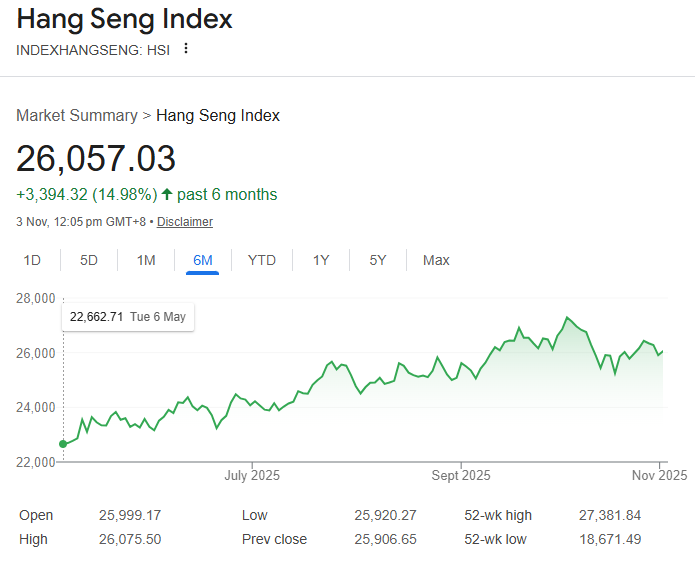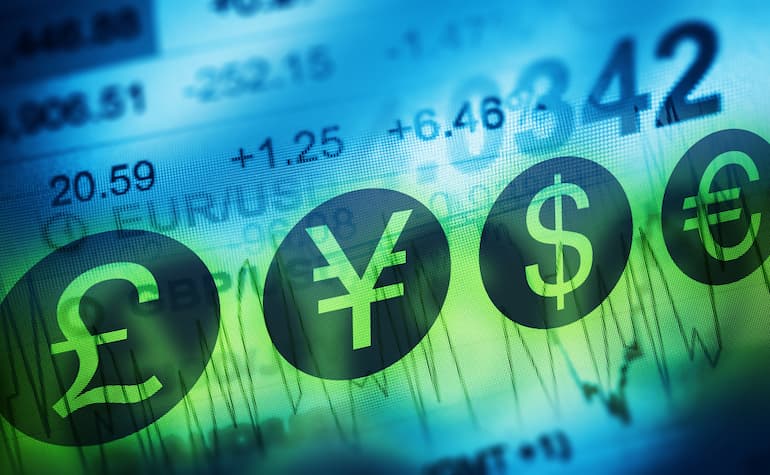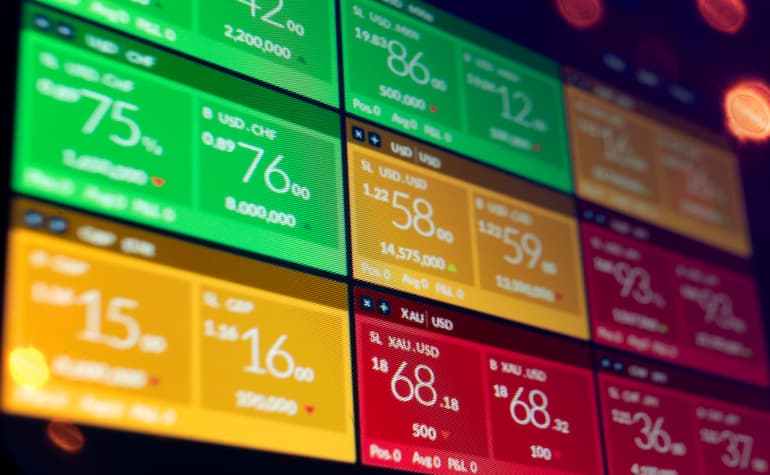市场资讯及洞察
%20(1).jpg)
震荡中的信号,港股能否迎来真正的底部?
10月,恒生指数延续回调格局,全月累计下跌948点,月初触及27,381点高位后快速回落至25,145点,跌幅达到61.8%的黄金比率水平,随后虽反弹至26,588点,但未能持续突破,显示短期受均线压制,向上动力有限。内地9月制造业PMI创半年低位且低于预期,加上全球宏观因素如美元走强、通胀压力持续,使恒指多次受挫,市场情绪谨慎。

进入11月,恒指夜期先行反弹69点,显示短期市场情绪略有回暖。此前美联储降息预期和中美贸易谈判利好消息已陆续落地,提供有限支撑,但短期缺乏新利好刺激,恒指重返高位可能性有限。若A股走势改善或科技股业绩超预期,恒指未来两个月仍有机会向今年高位27300点挑战。
本周一盘中,恒指回到26,000点附近震荡,显示市场仍在观望。技术面上,强势股指数微升,弱势股指数下降,优质板块仍具一定抗跌能力。整体来看,港股短期延续震荡整固格局,预计仍在25,300至26,300点区间震荡整理。

市场个股表现
从板块来看,科技股受业绩不及预期及全球芯片需求疲软影响出现回调;高股息蓝筹如银行、公用事业等抗跌板块成为资金避险首选;部分资源类个股受金属价格反弹支撑出现阶段性上涨;房地产板块风险仍存,部分开发商财务困境对市场情绪形成压制。总体而言,港股呈现“震荡筑底”态势,反映出市场在基本面、政策面及宏观因素间的博弈。
主要影响因素
- 美联储政策预期主导资金流向
多位美联储官员暗示降息窗口可能在明年上半年开启,短期推高风险资产包括港股和A股的资金流入。然而,美国通胀仍保持黏性,政策宽松节奏不确定,使市场短线资金频繁进出,缺乏持续上涨动力。对于港股而言,这意味着短期资金流入可能只是“阶段性反弹”,而非趋势性上涨。 - 内地经济复苏分化,港股估值修复受限
中国10月制造业PMI略低于荣枯线,显示复苏力度仍不足。尽管政策持续宽松,如专项债加速发行、房地产融资边际放松,但企业盈利恢复仍需时间。港股估值虽处历史低位,但市场仍在等待更强的基本面催化。投资者可关注政策落地力度及企业盈利改善的信号,这将决定港股后续的估值修复空间。 - 地缘局势与全球风险偏好
中东紧张局势持续,提升全球避险情绪,推动黄金、原油价格上行,部分风险资产承压。港股短期可能面临外资重新配置至美元或避险产品的压力,削弱流入力度。同时,人民币汇率波动也让南向资金趋于保守,进一步增加市场的不确定性。 - 宏观经济数据与市场情绪
美国通胀压力仍存,市场对降息预期降温,加息预期增强可能导致资金流出香港,从而对港股形成下行压力。中国经济数据虽显示复苏,但房地产市场调整拖累整体增长,使市场短期内难以形成强劲上涨动力。 - 行业特定新闻
中国科技行业监管政策仍是市场关注焦点。虽然监管有所缓和,但未来可能出台的新规仍对科技股产生压力,导致板块短期承压。投资者应关注科技股业绩发布及政策变化,以判断其中长期投资价值。 - 地缘政治因素
中美关系紧张、贸易摩擦及技术竞争仍在,对市场情绪形成影响。国际贸易环境的变化可能影响港企盈利前景,从而影响港股表现,尤其是出口导向型及高科技板块。
结构性机会与市场影响
尽管港股整体震荡,但结构性机会逐渐显现:高股息、现金流稳定的金融与公用事业板块受机构青睐;科技股短期承压,但AI、半导体及互联网龙头中长期前景仍被看好;新能源与资源板块受能源转型及金属价格上涨支撑;内地消费和旅游板块若政策落地,有望迎来补涨。
如果政策与市场流动性同步改善,恒指有望逐步筑底并展开估值修复;反之,若全球通胀回升或地缘风险加剧,市场可能继续维持震荡格局。短期来看,恒指预计将在25,300至26,300点区间震荡整固,投资者应关注内地经济数据、科技股业绩及全球宏观因素对市场的影响。
总体而言,港股正处筑底期,中长期投资价值逐步显现。投资者应保持审慎,密切关注市场动态,并结合板块机会进行合理配置,以应对潜在不确定性。
免责声明:GO Markets 分析师或外部发言人提供的信息基于其独立分析或个人经验。所表达的观点或交易风格仅代表其个人;并不代表 GO Markets 的观点或立场。
联系方式:
墨尔本 03 8658 0603
悉尼 02 9188 0418
中国地区(中文) 400 120 8537中国地区(英文) +248 4 671 903
作者:
Alena Wang | GO Markets 墨尔本中文部


GO Markets proudly announces its achievement of ISO 27001 certification. This milestone underscores GO Markets' unwavering commitment to safeguarding its clients’ information assets and affirms its commitment to maintaining information security at an industry-leading level. This standard, part of the ISO 27000 series, sets out the specifications for an effective Information Security Management System (ISMS), offering a comprehensive framework for organisations to manage their information security adeptly.
An ISMS, as per ISO 27001, employs a systematic approach to ensuring the Confidentiality, Integrity, and Availability (CIA) of corporate information assets, providing a robust defence against evolving cyber threats. GO Markets' ISO 27001 certification is a significant milestone in its ongoing pursuit of information security. By adhering to the highest standards of data protection, GO Markets reaffirms its dedication to maintaining the trust and confidence of its clients while setting a benchmark for security excellence in the financial services sector.
About the International Organisation for Standardisation (ISO) Created in 1946 to establish best practices spanning from product manufacturing to process management, the ISO has 25,297 International Standards covering nearly all facets of technology, management, and manufacturing. ISO fosters international trade and cooperation among its 170 member countries, each represented by a single member. Through 830 technical committees and subcommittees, ISO ensures meticulous standards development, adhering to its inclusive, value-driven, independent, can-do, and global ethos.
Its consensus-based approach integrates feedback from diverse stakeholders, fostering trust and collaboration. About DNV DNV is a global leader in assurance, risk management, and classification services, dedicated to safeguarding life, property, and the environment. They provide expertise and innovative solutions across various industries, ensuring the performance and safety of organisations and their assets worldwide.
They are one of the world’s leading certification bodies, delivering world-renowned testing, certification and technical advisory services.


Plenty has been made of the drive towards nickel and lithium as “future metals” as the world's “electrification” takes hold. This “electrification” has been nicknamed the “volt revolution” and when you get these kinds of technological leaps - what's appearing to be the “winner” now doesn't necessarily mean it will be the overall. That is where Nickel and Lithium need to be examined.
The demand for these two metals over the last 15 years has been staggering and for good reason the uptake of electronic vehicles (EVs), household batteries and the accelerated push to “net zero” have made these two metals – must haves. However as mentioned, will the demand hold up or will these metals experience the same market translation social media went through in the late 1990s and 2000s. Think about it what happened to market leaders Myspace and Yahoo?
Think about all those search engines that lost out to Google? Or the online marketplaces that have been cannibalised by Amazon. I raise this because although right now nickel and lithium are all the rage, there are signs they may lose out to cheaper and possibly faster technologies in the EV and battery space over the coming decades.
Nickel in particular looks to be the first one of these under pressure, and not surprising it’s from lithium itself. The light speed advancement in cheap and safe LFP batteries (lithium iron phosphate) is staggering. In fact, they are becoming so good at holding charge and efficiency that LFP batteries have now conquered 70% of the EV mass market in China further to this - they don't need nickel or cobalt like previous iterations.
Then there is the new manganese twist to the LFP batteries. “LMFP” uses manganese as a cathode which almost exponentially upscales the quality. These batteries are now approaching the energy density and range of standard high nickel batteries that are sold in all EVs across Europe in the US — but here is the kicker its two-thirds of the cost. So it would appear lithium is the winner with the LMFP battery technology - Again, I am not sure as battery technology using sulphur and potassium suggests we could see another leap forward in the range and charging time of these players and they are due to hit the market in the latter half of this decade, the catch here – they don’t use lithium in anywhere near the quantities originally forecast.
Let me dig a little further - the Department of Industry and Resources anticipates that lithium prices won't return to the peak levels seen in late 2022 until the end of 2029. Why? Throughout most of last year a surge in lithium production chased the high prices of 2022 leading to a substantial increase in global supply.
Couple that with weaker-than-expected demand for EVs in the US and Europe balanced the market and caused prices to drop significantly. (Source: Department of Industry and Resources) Supply and demand being what it is prices fell throughout 2023 resulting in reduced production, particularly among some higher-cost producers. Which brings us to the 20% increase in lithium price since the start of the year, and forecasts of further gains through to 2025 according to the same report from the Department of Industry, Resources, and Sciences. However, from 2026 onward, lithium-ion EV batteries will face the pressure from the technologies mentioned above.
The impact on lithium prices such as lithium spodumene according to the Department is prices to climb to US$1,360 per tonne by 2026 before declining to US$1,090 by 2029. The reason I want to use the department’s forecasting is it is historically conservative and directionally accurate. So, what does this all mean?
Larger lithium producers like Pilbara Minerals, Mineral Resources, and IGO are expected to remain profitable at current prices, but the outlook for marginal producers like Core Lithium and emerging players like Liontown is less certain, with questions about whether current prices are sufficient to support their projects. It also suggests that when it comes to future metals – nickel, lithium and the like, a short term view may be the better option as picking the eventual winner in the ‘volt revolution’ is far from certain.


Thin trading in FX markets continued in a holiday shortened week with G10 FX mostly flat against the USD in Wednesday’s session also looking like traders are waiting for Fridays key US PCE inflation reading. The highlights were: USDJPY pushed past its November 2023 high hitting 151.97 which is the highest level this pair has reached since 1990 and bringing intervention speculation to the fore once more, with some trading desks flagging the possibility of intervention during thin Easter markets. Comments from Finance Minister Suzuki who said he was closely watching FX moves and won't rule out any steps including decisive steps to respond to disorderly FX moves also stoking the intervention fire.
Gold surged higher with XAUUSD testing the previous all-time high and resistance level at 2195 USD an ounce after an earlier sell-off on a Reuters report that India is to drastically cut its gold imports in March. While the USD was flat, treasury yields did have a decent drop which supported the gold price. Today ahead in economic news, the highlights are US jobs and GDP data.


After last week’s blockbuster NFP figure FX traders have a key US CPI reading to look forward to later today. Rates markets have seen see-sawing expectations on when the Fed will start cutting rates and today’s CPI will be another big part of that puzzle. US CPI for March is expected to come in at a 0.3% increase, a slight cooling from Februarys 0.4% but still stubbornly holding the Year-on-Year rate at 3.4%, showing that not progress in the battle to bring down inflation is slow going and not over yet.
USD has been in a holding pattern during April with the US dollar Index range trading between the support at 104 and resistance at 105, the 104 support is certainly in play should a cooler than expected CPI reading come in, with the next support at the 200-day SMA at 103.81 Golds record run-up to all time highs has seen the precious metal take headlines during April. As an inflation hedge it should benefit from a hot CPI reading, but a cool reading would see yields and the USD drop which is also gold positive. It’s hard to predict how gold will react fundamentally to todays CPI, though from a chartist point of view XAUUSD is in serious overbought territory and a correction is overdue.


USD rallied in Tuesday’s session, with the US dollar Index hitting a 2024 high of 106.510 after hawkish Fed Chair Powell commentary where he noted recent data was showing a lack of further progress on inflation. Powell also added that if higher inflation persists the Fed can maintain current rate as long as needed. On data, building permits and housing starts came in beneath analyst expectations while industrial production was in line with forecasts but manufacturing output beat.
USDJPY moved higher for a 5 th straight session, with the pair closing the New York session at highs of 154.78. There was what appeared to be an intervention earlier in the US session with a steep 100 pip drop on no headlines that quickly retraced. This looked like a shot across the bow from the BoJ with market participants suspecting intervention and will likely strengthen expectations that 155.00 is the line in the sand for Japanese officials.


Data releases this week have hinted that the strong US activity story may be about to turn. The ISM services index declined more than expected, with the “prices paid” component slowing meaningfully to a four-year low. Yesterday, the NFIB reported that small business was looking to cut back on hiring and with small businesses accounting for almost half of total US jobs suggest we could see sub-50k payrolls by June.
Today’s March NFP figure is expected at 214k with some economists predicting a miss to the downside, a print below 200k should put pressure on the dollar given it’s high sensitivity to data recently as the market tries to get ahead of future Fed actions. The US Dollar Index (DXY) is currently trading between resistance at 105, which was the February high, and support at the psychological 104 level. Both these levels will be in play on the back of today’s NFP, FX traders will be watching for breaks or holds of these key levels to gauge short term momentum for DXY.
A May cut from the Fed looks off the table, but June remains in play with odds currently at 60% in the Fed Funds futures market. Should the pricing for a June cut move from 60% to 100%, the dollar may well take a bigger hit than what the swing in rate differentials would imply.

